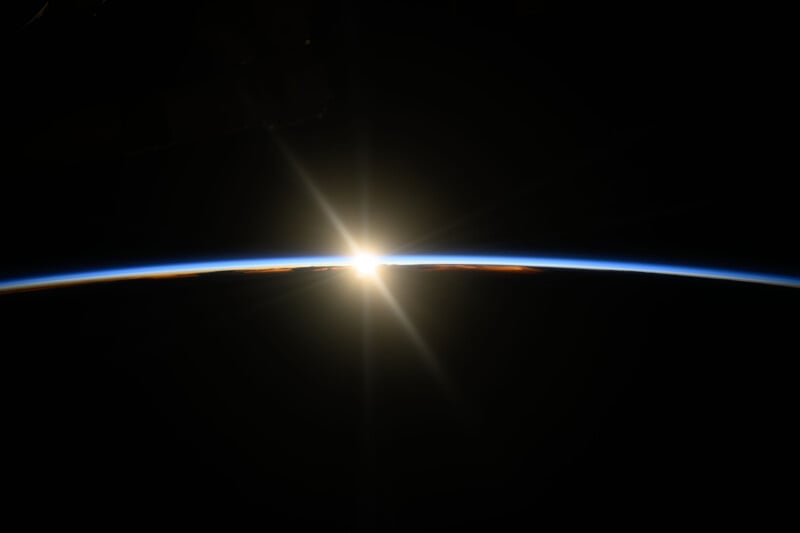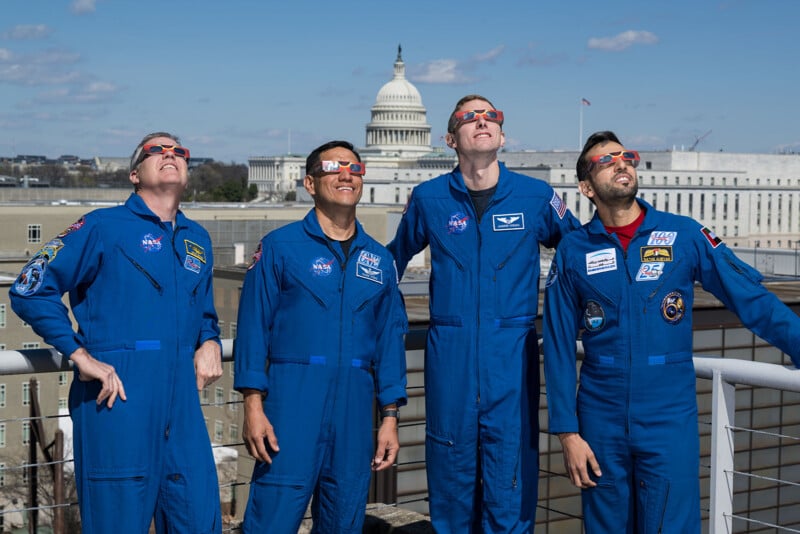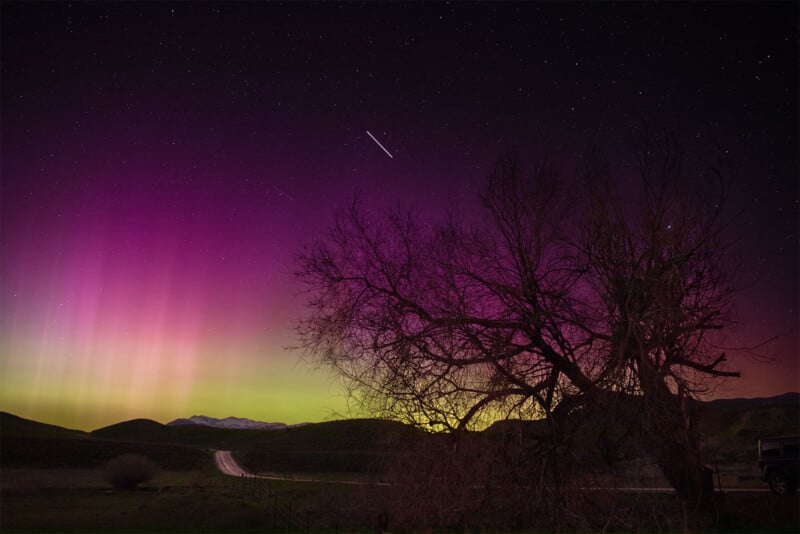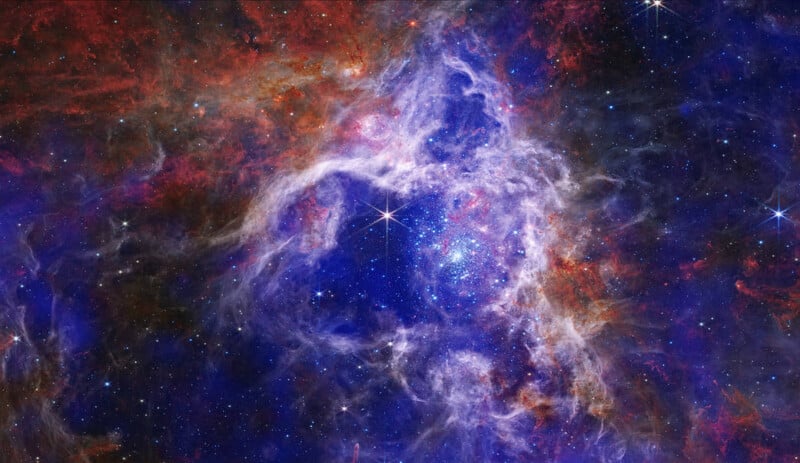 NASA astronaut Suni Williams, who is currently stranded in space, onboard the ISS, left, and Hurricane Milton over the Gulf of Mexico, right.
NASA astronaut Suni Williams, who is currently stranded in space, onboard the ISS, left, and Hurricane Milton over the Gulf of Mexico, right.NASA has shared some of its top images of 2024 featuring faraway galaxies, leaf peeping from onboard the International Space Station (ISS), and the space agency’s ongoing mission to make interplanetary travel a reality.
The gallery also features images of Hurricane Milton as seen by the astronauts onboard the ISS, as well as satellite imagery of lava flowing out of a volcano in Iceland near to the country’s Blue Lagoon spa.
 An astronaut aboard the International Space Station shot this photo of peak fall colors around Ottawa, the capital of Canada. West of downtown Ottawa lies Gatineau Park, where sugar maple leaves turn orange-red and hickories turn golden-bronze during the season, known regionally as “the Fall Rhapsody.”
An astronaut aboard the International Space Station shot this photo of peak fall colors around Ottawa, the capital of Canada. West of downtown Ottawa lies Gatineau Park, where sugar maple leaves turn orange-red and hickories turn golden-bronze during the season, known regionally as “the Fall Rhapsody.” The International Space Station was orbiting on a northeast track 261 miles above the Pacific Ocean when this photograph captured the first rays of an orbital sunrise illuminating Earth’s atmosphere. | NASA/Matthew Dominick
The International Space Station was orbiting on a northeast track 261 miles above the Pacific Ocean when this photograph captured the first rays of an orbital sunrise illuminating Earth’s atmosphere. | NASA/Matthew Dominick A SpaceX Falcon 9 rocket carrying Intuitive Machines’ Nova-C lunar lander lifts off from Launch Pad 39A at NASA’s Kennedy Space Center in Florida at 1:05 a.m. EST on Thursday, Feb. 15, 2024. As part of NASA’s CLPS (Commercial Lunar Payload Services) initiative and Artemis campaign, Intuitive Machines’ first lunar mission will carry NASA science and commercial payloads to the Moon to study plume-surface interactions, space weather/lunar surface interactions, radio astronomy, precision landing technologies, and a communication and navigation node for future autonomous navigation technologies. | NASA/Kim Shiflett
A SpaceX Falcon 9 rocket carrying Intuitive Machines’ Nova-C lunar lander lifts off from Launch Pad 39A at NASA’s Kennedy Space Center in Florida at 1:05 a.m. EST on Thursday, Feb. 15, 2024. As part of NASA’s CLPS (Commercial Lunar Payload Services) initiative and Artemis campaign, Intuitive Machines’ first lunar mission will carry NASA science and commercial payloads to the Moon to study plume-surface interactions, space weather/lunar surface interactions, radio astronomy, precision landing technologies, and a communication and navigation node for future autonomous navigation technologies. | NASA/Kim Shiflett Teams with NASA’s Exploration Ground Systems transport lower the agency’s 212-foot-tall SLS (Space Launch System) core stage into High Bay 2 at the Vehicle Assembly Building at NASA’s Kennedy Space Center in Florida on Wednesday, Dec. 11, 2024. The one-of-a-kind lifting beam is designed to lift the core stage from the transfer aisle to High Bay 2 where it will remain while teams stack the two solid rocket boosters on top of mobile launcher 1 for the SLS core stage. | NASA/Kim Shiflett
Teams with NASA’s Exploration Ground Systems transport lower the agency’s 212-foot-tall SLS (Space Launch System) core stage into High Bay 2 at the Vehicle Assembly Building at NASA’s Kennedy Space Center in Florida on Wednesday, Dec. 11, 2024. The one-of-a-kind lifting beam is designed to lift the core stage from the transfer aisle to High Bay 2 where it will remain while teams stack the two solid rocket boosters on top of mobile launcher 1 for the SLS core stage. | NASA/Kim Shiflett NASA astronauts Stephen Bowen, left, Frank Rubio, Warren Hoburg, and UAE (United Arab Emirates) astronaut Sultan Alneyadi, right, pose for a photo wearing solar glasses, Tuesday, March 19, 2024, at the Mary W. Jackson NASA Headquarters building in Washington. Bowen, Hoburg, and Alneyadi spent 186 days aboard the International Space Station as part of Expedition 69; while Rubio set a new record for the longest single spaceflight by a U.S. astronaut, spending 371 days in orbit on an extended mission spanning Expeditions 68 and 69. | NASA/Aubrey Gemignani
NASA astronauts Stephen Bowen, left, Frank Rubio, Warren Hoburg, and UAE (United Arab Emirates) astronaut Sultan Alneyadi, right, pose for a photo wearing solar glasses, Tuesday, March 19, 2024, at the Mary W. Jackson NASA Headquarters building in Washington. Bowen, Hoburg, and Alneyadi spent 186 days aboard the International Space Station as part of Expedition 69; while Rubio set a new record for the longest single spaceflight by a U.S. astronaut, spending 371 days in orbit on an extended mission spanning Expeditions 68 and 69. | NASA/Aubrey Gemignani This high exposure photograph from the International Space Station shows Earth’s atmospheric glow and a starry sky as the orbital complex soared above the Pacific Ocean.
This high exposure photograph from the International Space Station shows Earth’s atmospheric glow and a starry sky as the orbital complex soared above the Pacific Ocean. In a historic first, all six radio frequency antennas at the Madrid Deep Space Communication Complex – part of NASA’s Deep Space Network (DSN) – carried out a test to receive data from the agency’s Voyager 1 spacecraft at the same time on April 20, 2024. Known as “arraying,” combining the receiving power of several antennas allows the DSN to collect very faint signals from faraway spacecraft. A five-antenna array is currently needed to downlink science data from the spacecraft’s Plasma Wave System instrument. As Voyager gets further away, six antennas will be needed. | MDSCC/INTA, Francisco “Paco” Moreno
In a historic first, all six radio frequency antennas at the Madrid Deep Space Communication Complex – part of NASA’s Deep Space Network (DSN) – carried out a test to receive data from the agency’s Voyager 1 spacecraft at the same time on April 20, 2024. Known as “arraying,” combining the receiving power of several antennas allows the DSN to collect very faint signals from faraway spacecraft. A five-antenna array is currently needed to downlink science data from the spacecraft’s Plasma Wave System instrument. As Voyager gets further away, six antennas will be needed. | MDSCC/INTA, Francisco “Paco” Moreno Landsat 9 captured this image of lava coming from an eruptive fissure near Stóra Skógfell peak on Iceland’s Reykjanes peninsula. Lava from the eruption flowed across major roads and closed in on the Blue Lagoon, a popular tourist destination. This natural color scene is overlaid with an infrared signal to help distinguish the lava’s heat signature. | NASA/Michala Garrison, using Landsat data from the U.S. Geological Survey and VIIRS day-night band data from the Suomi National Polar-orbiting Partnership
Landsat 9 captured this image of lava coming from an eruptive fissure near Stóra Skógfell peak on Iceland’s Reykjanes peninsula. Lava from the eruption flowed across major roads and closed in on the Blue Lagoon, a popular tourist destination. This natural color scene is overlaid with an infrared signal to help distinguish the lava’s heat signature. | NASA/Michala Garrison, using Landsat data from the U.S. Geological Survey and VIIRS day-night band data from the Suomi National Polar-orbiting Partnership These shape-shifting galaxies have taken on the form of a giant mask. The icy blue eyes are actually the cores of two merging galaxies, called NGC 2207 and IC 2163, and the mask is their spiral arms. The false-color image consists of infrared data from NASA’s Spitzer Space Telescope (red) and visible data from NASA’s Hubble (blue/green).
These shape-shifting galaxies have taken on the form of a giant mask. The icy blue eyes are actually the cores of two merging galaxies, called NGC 2207 and IC 2163, and the mask is their spiral arms. The false-color image consists of infrared data from NASA’s Spitzer Space Telescope (red) and visible data from NASA’s Hubble (blue/green). The aurora turns the sky near Malad City, Idaho, red, purple, and green in this 8-second exposure taken on May 11, 2024. | NASA/Bill Dunford
The aurora turns the sky near Malad City, Idaho, red, purple, and green in this 8-second exposure taken on May 11, 2024. | NASA/Bill Dunford Hurricane Milton is pictured as a category 4 storm in the Gulf of Mexico nearing the coast of Florida in this photograph from the International Space Station as it orbited 257 miles above. The SpaceX Dragon Freedom spacecraft is also pictured from a window on the Dragon Endeavour spacecraft. | NASA/Matthew Dominick
Hurricane Milton is pictured as a category 4 storm in the Gulf of Mexico nearing the coast of Florida in this photograph from the International Space Station as it orbited 257 miles above. The SpaceX Dragon Freedom spacecraft is also pictured from a window on the Dragon Endeavour spacecraft. | NASA/Matthew Dominick NASA astronaut and Expedition 72 Commander Suni Williams checks out the Astrobee robotic free-flyer in the Kibo laboratory module outfitted with tentacle-like arms containing gecko-like adhesive pads to demonstrate satellite capture techniques. Development of this robotic technology may increase the life span of satellites and enable the removal of space debris.
NASA astronaut and Expedition 72 Commander Suni Williams checks out the Astrobee robotic free-flyer in the Kibo laboratory module outfitted with tentacle-like arms containing gecko-like adhesive pads to demonstrate satellite capture techniques. Development of this robotic technology may increase the life span of satellites and enable the removal of space debris. Photographers at NASA capture the sunset on Tuesday, Jan. 30, 2024, near Vehicle Assembly Building at the agency’s Kennedy Space Center in Florida. The iconic Vehicle Assembly Building, completed in 1966 and currently used for assembly of NASA’s Space Launch System rocket for Artemis missions, remains the only building in which rockets were assembled that carried humans to the surface of another world. | NASA/Ben Smegelsky
Photographers at NASA capture the sunset on Tuesday, Jan. 30, 2024, near Vehicle Assembly Building at the agency’s Kennedy Space Center in Florida. The iconic Vehicle Assembly Building, completed in 1966 and currently used for assembly of NASA’s Space Launch System rocket for Artemis missions, remains the only building in which rockets were assembled that carried humans to the surface of another world. | NASA/Ben Smegelsky Technicians move NASA’s Europa Clipper spacecraft inside the Payload Hazardous Servicing Facility to accommodate installation of its five-panel solar array at the agency’s Kennedy Space Center in Florida on Thursday, Aug. 1, 2024. After moving the spacecraft, the team had to precisely align the spacecraft in preparation for the installation. The huge arrays – spanning more than 100 feet when fully deployed, or about the length of a basketball court – will collect sunlight to power the spacecraft as it flies multiple times around Jupiter’s icy moon, Europa, conducting science investigations to determine its potential to support life. | NASA/Frank Michaux
Technicians move NASA’s Europa Clipper spacecraft inside the Payload Hazardous Servicing Facility to accommodate installation of its five-panel solar array at the agency’s Kennedy Space Center in Florida on Thursday, Aug. 1, 2024. After moving the spacecraft, the team had to precisely align the spacecraft in preparation for the installation. The huge arrays – spanning more than 100 feet when fully deployed, or about the length of a basketball court – will collect sunlight to power the spacecraft as it flies multiple times around Jupiter’s icy moon, Europa, conducting science investigations to determine its potential to support life. | NASA/Frank Michaux The “Tarantula Nebula” (officially known as 30 Doradus) is available in a composite image of Chandra and JWST data for the first time.
The “Tarantula Nebula” (officially known as 30 Doradus) is available in a composite image of Chandra and JWST data for the first time. Hurricane Milton, a Category 5 storm at the time of this photograph, is pictured in the Gulf of Mexico off the coast of Yucatan Peninsula from the International Space Station as it orbited 257 miles above.
Hurricane Milton, a Category 5 storm at the time of this photograph, is pictured in the Gulf of Mexico off the coast of Yucatan Peninsula from the International Space Station as it orbited 257 miles above.The full gallery can be seen here.
Image credits: Courtesy of NASA.






 English (US) ·
English (US) ·